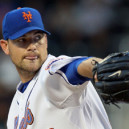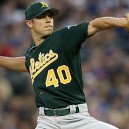
Scott Diamond is one of two remaining starters from 2012
In 2012, the Minnesota Twins endured their second straight ninety-plus loss season. While their hitting wasn’t spectacular (combined 99 OPS+, which was slightly below league average of 100 OPS+), it was really their pitching that did them in.
The Twins pitching staff ranked second-to-last in the American League with a combined 85 ERA+. Considering the league average was a 101 ERA+, the 2012 Twins’ hurlers were pretty pathetic.
The Twins used ten starting pitchers in 2012, with the below WAR:
Scott Diamond: 2.2
Sam Deduno: 0.5
Cole De Vries: 0.2
Esmerling Vasquez: -0.2
Francisco Liriano: -0.5
P.J. Walters: -0.6
Carl Pavano: -0.8
Jason Marquis: -1.2
Liam Hendriks: -1.2
Nick Blackburn: -2.3
The combination of those ten pitchers amounted to -3.9 WAR.
Luckily for the Twins, the only two remaining starters from 2012 were their two top ones– Scott Diamond and Sam Deduno–and through trades and free-agent signings, the Twins have replaced their lesser pitchers with Vance Worley, Kevin Correia, Mike Pelfrey, and Rich Harden.
Even though the acquisitions have been met with a lot of criticism, compared to their 2012 staff, the 2013 Twins starters should still be slightly improved.
VANCE WORLEY
 Worley is just a year removed from a 3.2 WAR season (3.01 ERA, 1.23 WHIP, 2.59 K/BB), and posted a 0.7 WAR in 2012.
Worley is just a year removed from a 3.2 WAR season (3.01 ERA, 1.23 WHIP, 2.59 K/BB), and posted a 0.7 WAR in 2012.
Considering the 25 year-old righty pitched through a .340 BABIP (vs. .283 BABIP in 2012), and a spiked GB% (from 39.3% to 46.0%) last season, it’s possible he’ll pitch closer to his 4.04 xFIP than his 4.20 ERA in 2013.
Worley even has potential to be more valuable than the Twins “ace” Scott Diamond due to his ability to strikeout batters.
KEVIN CORREIA
 Correia was the Twins biggest free-agent acquisition, signing a two-year, $10 million contract this off-season.
Correia was the Twins biggest free-agent acquisition, signing a two-year, $10 million contract this off-season.
The move was a bit of a curious one as the 32 year-old hasn’t posted a 90-plus ERA+ since his “breakout” season (as a full-time starter) since 2009.
His -0.1 WAR certainly won’t hurt the Twins, but then again, it’s barely an upgrade over less costly pitchers like Cole De Vries, Esmerling Vasquez, and P.J. Walters.
MIKE PELFREY
 Yes, it was just 19.6 innings, but regardless, Pelfrey was en route to his best career season in 2012 before tearing his UCL, and opting for season-ending Tommy John surgery.
Yes, it was just 19.6 innings, but regardless, Pelfrey was en route to his best career season in 2012 before tearing his UCL, and opting for season-ending Tommy John surgery.
It was unfortunate timing for the 28 year-old, as the former first round pick never lived up to his supposed “future rotation anchor” label.
On the surface, Big Pelf’s lack of success is a bit befuddling, as the righty throws a consistent 93 MPH fastball, and “boasts” four other pitches in his arsenal.
But, Pelfrey has his fair share of shortcomings.
According to RAA (runs above average), none of his pitches are truly above league-average, the righty possesses league-average control (career 3.2 BB/9) while owning a meager 5.1 K/9 career rate, and his career 4.50 xFIP is in-line with his career 4.36 ERA.
So Pelfrey is about as predictably mediocre as it gets.
Yet, even mediocrity has a price. If Pelfrey pitches closer to his 2010-self (2.3 WAR) than his 2011-self (0.0 WAR), there’s a chance Pelf could be a serviceable middle-rotation pitcher for the Twins in 2013.
RICH HARDEN
 The problem with Harden isn’t talent, as the righty has posted three 3-plus WAR seasons in his career.
The problem with Harden isn’t talent, as the righty has posted three 3-plus WAR seasons in his career.
The only reason the former Oakland Athletics stud-prospect doesn’t have more productive seasons under his belt is due to his incredible knack for injuries.
Harden has been injured more times than Dolly Parton has had plastic surgery (I count around nine DL stints for Harden, but it could be more).
It’s difficult to ascertain as to whether the 31 year-old will be actually be a full-time asset in 2013, but even with his declining velocity, one has to think that 80 innings of Rich Harden is superior to 80 innings of Carl Pavano.
Bottom Line
As unexciting as adding Vance Worley, Kevin Correia, Mike Pelfrey, and Rich Harden may be, their addition still marks a noticeable improvement over the cast of characters the Twins were forced to use in 2012.
Whether the Twins new rotation filled with four and five starts will make the team anything other than cellar-dwellers, is a different question altogether.
